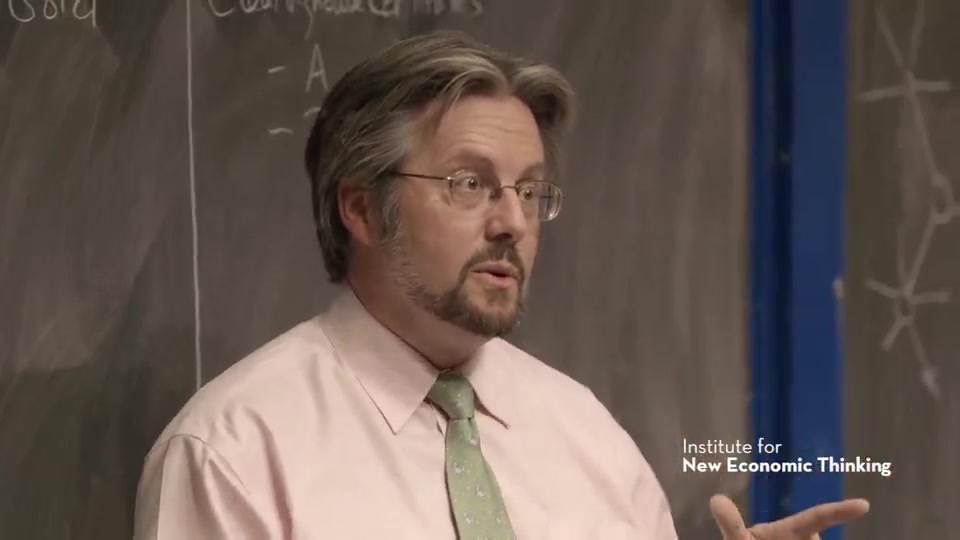- 在线播放
- 分集下载
- 1-1 The Big Picture (19-20)
- 1-2 Prerequisites- (7-21)
- 1-3 What is a Bank, a Shadow Bank, a Central Bank- (12-10)
- 1-4 Central Themes (13-07)
- 1-5 Reading- Allyn Young (3-10)
- 2-1 FT- The Eurocrisis, Liquidity vs. Solvency (10-06)
- 2-2 Hierarchy of Financial Instruments (9-39)
- 2-3 Hierarchy of Financial Institutions (6-37)
- 2-4 Dynamics of the Hierarchy (6-08)
- 2-5 Discipline and Elasticity, Currency Principle and Banking Principle
- 2-6 Hierarchy of Market Makers (9-16)
- 2-7 Managing the Hierarchy (18-03)
- 3-1 FT- Quantitative Easing and the Fed (7-48)
- 3-2 Allyn Young- Money and Economic Orthodoxy (9-09)
- 3-3 National Banking System before the Fed (3-22)
- 3-4 Civil War Finance, bonds and loans (8-49)
- 3-5 Civil War Finance, legal tenders (7-05)
- 3-6 National Banking System, origins (6-28)
- 3-7 National Banking System, instability (5-57)
- 3-8 Federal Reserve System, plan (6-32)
- 3-9 Federal Reserve System, actual (6-47)
- 4-1 FT- Dealer of Last Resort (5-24)
- 4-2 Reading- Hyman Minsky (3-07)
- 4-3 Payments- Money and Credit (5-35)
- 4-4 Payments- Discipline and Elasticity (4-13)
- 4-5 The Survival Constraint (3-35)
- 4-6 Sources and Uses Accounts (6-54)
- 4-7 Payment Example- Money and Credit (10-05)
- 4-8 Flow of Funds Accounts (10-10)
- 4-9 The Survival Constraint, redux (2-40)
- 4-10 Liquidity, Long and Short (9-42)
- 4-11 Financial Fragility, Flows and Stocks (6-23)
- 5-1 FT- Martin Wolf on QE3 (3-17)
- 5-2 One Big Bank (8-20)
- 5-3 Multiple Banks, a challenge (3-56)
- 5-4 Reading- Charles F. Dunbar (2-05)
- 5-5 Correspondent banking, bilateral balances (10-24)
- 5-6 Correspondent banking, system network (3-55)
- 5-7 Clearinghouse, normal operations (8-28)
- 5-8 Clearinghouse, private lender of last resort (10-44)
- 5-9 Central Bank Clearing (4-54)
- 5-10 Central Bank Cooperation (5-41)
- 6-1 FT- European Bank Deleveraging (5-44)
- 6-2 What are Fed Funds- (5-13)
- 6-3 Payment settlement versus Required Reserves (1-10)
- 6-4 Payment elasticity-discipline, Public and Private (9-03)
- 6-5 The Function of the Fed Funds Market (9-15)
- 6-6 Payment versus Funding- an example (11-24)
- 6-7 Brokers versus Dealers (2-03)
- 6-8 Payments Imbalances and the Fed Funds Rate (7-06)
- 6-9 Secured versus Unsecured Interbank Credit (5-05)
- 6-10 Required Reserves, redux (7-20)
- 7-1 FT- The impact of QE3 (2-46)
- 7-2 Money Market Interest Rate Patterns (3-34)
- 7-3 What is repo- (3-19)
- 7-4 Repo in balance sheets (7-34)
- 7-5 Comparison with Fed Funds (5-09)
- 7-6 Legal construction of repo (9-46)
- 7-7 Security dealers balance sheet (11-07)
- 7-8 Repo, modern finance, and the Fed (8-49)
- 7-9 Interest rate spreads- before the crisis (5-33)
- 7-10 Interest rate spreads- after the crisis (8-07)
- 8-1 FT- Ring-fencing and the Volcker Rule (9-46)
- 8-2 The Eurodollar Market in Crisis (4-51)
- 8-3 What are Eurodollars- (7-11)
- 8-4 Why is there a Eurodollar market- (4-43)
- 8-5 Eurodollar as global funding market (11-33)
- 8-6 Liquidity challenge of Eurodollar banks (10-59)
- 8-7 FRA as implicit swap of IOUs (4-34)
- 8-8 Forward Parity, Interest Rates, EH (3-13)
- 8-9 Forward Parity, Exchange Rates, UIP (5-53)
- 8-10 Forward rates are NOT expected spot rates (2-48)
- 9-1 FT- Depreciation of Iran-'s currency (3-39)
- 9-2 Reading- John Hicks (3-38)
- 9-3 Bagehot-'s World, wholesale money market (7-57)
- 9-4 Economizing on notes- deposits, acceptances (8-28)
- 9-5 Managing cash flow- discount, rediscount (7-29)
- 9-6 Market rate of interest (2-44)
- 9-7 Central Bank and bank rate (8-13)
- 9-8 The Bagehot Rule, origin of monetary policy (4-38)
- 9-9 Limits on central banking- internal vs. external drain (10-20)
- 10-1 FT- Asymmetric Credit Growth in Europe (6-35)
- 10-2 Market liquidity, dealers, and inventories (7-10)
- 10-3 Two-sided dealer basics (6-31)
- 10-4 Economics of the dealer function- the Treynor model (11-43)
- 10-5 Leveraged dealer basics (7-23)
- 10-6 Real world dealers (7-56)
- 10-7 Arbitrage and the assumption of perfect liquidity (9-41)
- 11-1 FT- Money Market Mutual Funds (6-47)
- 11-2 Banks as money dealers, a puzzle (4-15)
- 11-3 Security dealers as money dealers, matched and speculative book (1
- 11-4 Adapting Treynor to liquidity risk (6-33)
- 11-5 Digression- Evolution of American banking (11-30)
- 11-6 The Fed in the Fed Funds market (12-48)
- 11-7 Return to the initial puzzle (2-14)
梅林的货币银行学的相关介绍
我们给您收录的这部来自Coursera平台的梅林的货币银行学视频教程为您由浅入深的介绍了货币银行学的理论框架,以及货币与货币制度、信用与金融市场、金融中介与金融机构、利息与利率、商业银行与存款等内容。
银行是通过存款、贷款、汇兑、储蓄等业务,承担信用中介的金融机构。银行是金融机构之一,而且是最主要的金融机构,它主要的业务范围有吸收公众存款、发放贷款以及办理票据贴现等。在我国,中国人民银行是我国的中央银行。
货币是指任何一种可以执行交换媒介、价值尺度、延期支付标准和完全流动的财富储藏手段等功能的商品,都可被看作是货币;从商品中分离出来固定地充当一般等价物的商品,就是货币;货币是商品交换发展到一定阶段的产物。货币的本质就是一般等价物。
在马克思对货币起源的分析中,货币的前身就是普普通通的商品,它是在交换过程中逐渐演变成一般等价物的。马克思创立货币理论的时代,正是各国普遍实行金铸币流通的时代,因此,马克思将黄金视为货币的最高阶段,而黄金本身就是价值十足的商品。进一步的推论就是,任何在商品交换中充当货币的东西,首先就在于它们是商品,与普通商品一样,都具有价值和使用价值。没有这种与普通商品的共性,货币就不具备与商品进行交换的基础。
货币应该分为两个阶段定义古典货币:是指任何一种可以执行交换媒介、价值尺度、延期支付标准和完全流动的财富的储藏手段等功能的商品,都可被看作是古典货币;从商品中分离出来固定地充当一般等价物的商品,就是古典货币;古典货币是商品交换发展到一定阶段的产物。古典货币的本质就是一般等价物。
现代货币:是指以某一权力机构为依托,在一定时期一定地域内推行的一种可以执行交换媒介、价值尺度、延期支付标准及作为完全流动的财富的储藏手段等功能的凭证。一般可以分为纸凭证及电子凭证,就是人们常说的纸币及电子货币。
古典货币与现代货币的区别在于:古典货币本身是商品,本质就是一般等价物,不依附于任何的权力机构,不会随权力机构的消亡而消亡。现代货币是一种凭证,依托于某一权力机构而存在,随权力机构的消亡而消亡。可以说现代货币在作为交换媒介、价值尺度、延期支付标准方面功能绝非古典货币所能比拟,但作为财富储藏手段方面的功能要逊色于古典货币,即使储存再多的凭证其功能也会随权力机构的消亡而消亡。
经过长年的自然淘汰,在绝大多数社会里,作为货币使用的物品逐渐被金属所取代。使用金属货币的好处是它的制造需要人工,无法从自然界大量获取,同时还易储存。数量稀少的金、银和冶炼困难的铜逐渐成为主要的货币金属。某些国家和地区使用过铁质货币。
早期的金属货币是块状的,使用时需要先用试金石测试其成色,同时还要秤量重量。随着人类文明的发展,逐渐建立了更加复杂而先进的货币制度。古代希腊、罗马和波斯的人们铸造重量、成色统一的硬币。这样,在使用货币的时候,既不需要秤量重量,也不需要测试成色,无疑方便得多。这些硬币上面带有国王或皇帝的头像、复杂的纹章和印玺图案,以免伪造。
中国最早的金属货币是商朝的铜贝。商代在我国历史上也称青铜器时代,当时相当发达的青铜冶炼业促进了生产的发展和交易活动的增加。于是,在当时最广泛流通的贝币由于来源的不稳定而使交易发生不便,人们便寻找更适宜的货币材料,自然而然集中到青铜上,青铜币应运而生。但这种用青铜制作的金属货币在制作上很粗糙,设计简单,形状不固定,没有使用单位,在市场上也未达到广泛使用的程度。由于其外形很像作为货币的贝币,因此人们大都将其称为铜贝。
据考古材料分析,铜贝产生以后,是与贝币同时流通的,铜贝发展到春秋中期,又出现了新的货币形式,即包金铜贝,它是在普通铜币的外表包一层薄金,既华贵又耐磨。铜贝不仅是我国最早的金属货币,也是世界上最早的金属货币。





